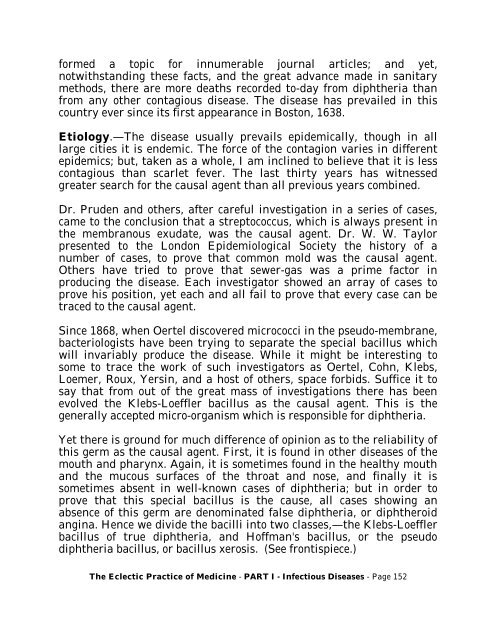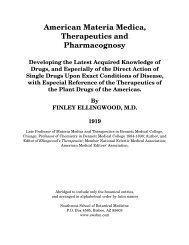SCARLET FEVER. Synonyms.—Scarlatina; Scarlet Rash. Definition ...
SCARLET FEVER. Synonyms.—Scarlatina; Scarlet Rash. Definition ...
SCARLET FEVER. Synonyms.—Scarlatina; Scarlet Rash. Definition ...
You also want an ePaper? Increase the reach of your titles
YUMPU automatically turns print PDFs into web optimized ePapers that Google loves.
formed a topic for innumerable journal articles; and yet,<br />
notwithstanding these facts, and the great advance made in sanitary<br />
methods, there are more deaths recorded to-day from diphtheria than<br />
from any other contagious disease. The disease has prevailed in this<br />
country ever since its first appearance in Boston, 1638.<br />
Etiology.—The disease usually prevails epidemically, though in all<br />
large cities it is endemic. The force of the contagion varies in different<br />
epidemics; but, taken as a whole, I am inclined to believe that it is less<br />
contagious than scarlet fever. The last thirty years has witnessed<br />
greater search for the causal agent than all previous years combined.<br />
Dr. Pruden and others, after careful investigation in a series of cases,<br />
came to the conclusion that a streptococcus, which is always present in<br />
the membranous exudate, was the causal agent. Dr. W. W. Taylor<br />
presented to the London Epidemiological Society the history of a<br />
number of cases, to prove that common mold was the causal agent.<br />
Others have tried to prove that sewer-gas was a prime factor in<br />
producing the disease. Each investigator showed an array of cases to<br />
prove his position, yet each and all fail to prove that every case can be<br />
traced to the causal agent.<br />
Since 1868, when Oertel discovered micrococci in the pseudo-membrane,<br />
bacteriologists have been trying to separate the special bacillus which<br />
will invariably produce the disease. While it might be interesting to<br />
some to trace the work of such investigators as Oertel, Cohn, Klebs,<br />
Loemer, Roux, Yersin, and a host of others, space forbids. Suffice it to<br />
say that from out of the great mass of investigations there has been<br />
evolved the Klebs-Loeffler bacillus as the causal agent. This is the<br />
generally accepted micro-organism which is responsible for diphtheria.<br />
Yet there is ground for much difference of opinion as to the reliability of<br />
this germ as the causal agent. First, it is found in other diseases of the<br />
mouth and pharynx. Again, it is sometimes found in the healthy mouth<br />
and the mucous surfaces of the throat and nose, and finally it is<br />
sometimes absent in well-known cases of diphtheria; but in order to<br />
prove that this special bacillus is the cause, all cases showing an<br />
absence of this germ are denominated false diphtheria, or diphtheroid<br />
angina. Hence we divide the bacilli into two classes,—the Klebs-Loeffler<br />
bacillus of true diphtheria, and Hoffman's bacillus, or the pseudo<br />
diphtheria bacillus, or bacillus xerosis. (See frontispiece.)<br />
The Eclectic Practice of Medicine - PART I - Infectious Diseases - Page 152

















